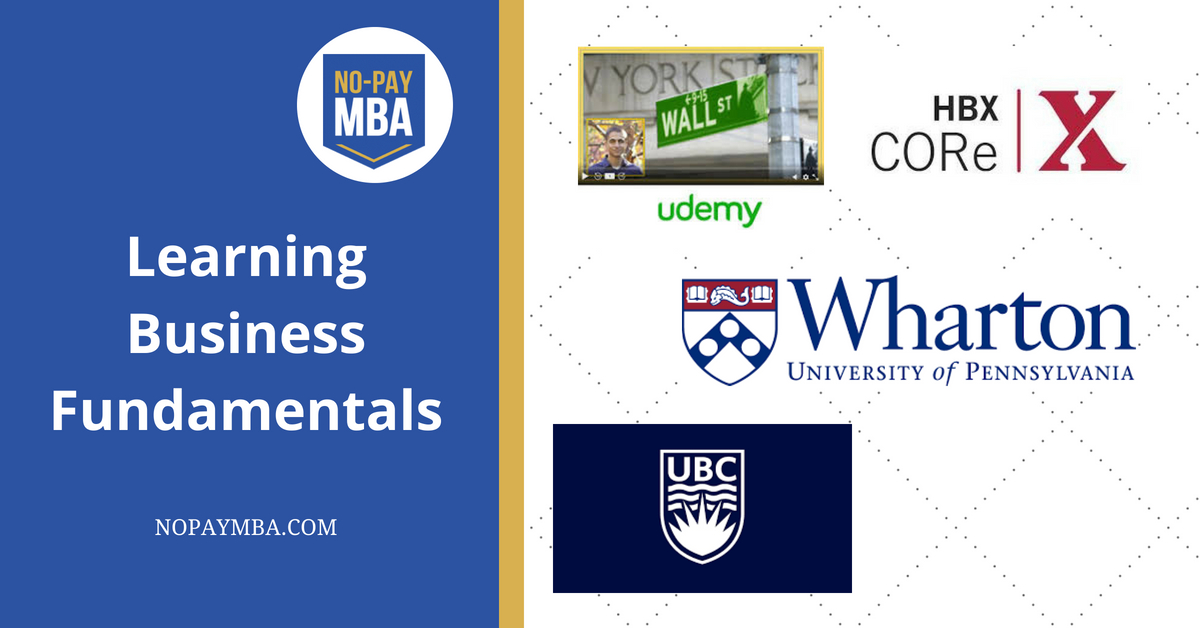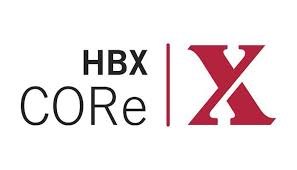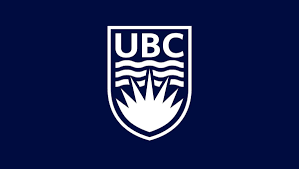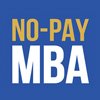by Laurie Pickard | Dec 28, 2013 | MOOC MBA Design

Crafting your own No-Pay MBA requires a bit more creativity than simply enrolling in an off-the-shelf business program. That said, the process is fun, and it allows for plenty of flexibility – and of course an enormous savings. Here’s how to do it:
1. Ask yourself: What do I hope to achieve by getting an MBA?
Your goal should be realistic and attainable. You will probably want to determine if your needs are better served by getting a traditional MBA. For example, if you want to be a Wall Street investment banker or stock broker, you might need the connections and the cred that come with a traditional MBA. However, if you want to start your own business, advance in your current job, or be eligible for jobs related to your current field that require an understanding of business, a No-Pay MBA could be perfect for you. You can see more of my thinking on this topic here. You might even float the idea to your supervisor by saying something like, “I’m looking into taking business courses. Would it be possible for me to take on some new responsibilities as I acquire new skills?”
2. Ask yourself: Do I have the time to commit to earning an MBA?
This is a very important step. You should budget at least four hours per week per course. If you plan to take two courses at a time (which is what I am doing), then you should expect to spend eight hours each week doing coursework. When I first started my No-Pay MBA I was between jobs, and I loaded up on courses, taking four at once, which was practically a full time job! Now that I’m working, I don’t have time to listen to lectures and do homework during the week, so I block off Saturday mornings to work on my MBA.
3. Make a list of topics you want to cover
I made my checklist by consulting the curriculum pages on the websites of Wharton, Harvard Business School, MIT’s business school, and a couple of others. You could do the same, or you could use the checklist below. I would caution against trying to duplicate my MBA or any other MOOC-based MBA course for course – as per the recommendation in this article, for example – because course availability is not guaranteed from semester to semester. Rather, I would focus on one set of topics during the first year (or first half) and a second set of topics during the second year/second half of your MBA. Check out this post and this page to see how I’ve done my first year.
A general checklist is as follows:
First year
These core courses:
o Accounting
o Corporate Finance
o Marketing
o Management (I would recommend at least two courses in management in the first year. These could include operations management, project management, leadership, small business management, etc.)
Plus three of the following:
o Technology in business
o Microeconomics
o Business ethics
o Organizational psychology
o Human resources management
o Entrepreneurship
o Business innovation
Second year
o Advanced topics in finance, corporate valuation, or accounting
o Business planning
o Business ethics
o Advanced topics in management
o Supply chain management
o Three to four courses related to an area of particular interest (mine is sustainable supply chain management for agri-business)
4. Set ambitious but realistic targets
Now that you have your checklist and you’ve made a commitment to spend time working on your MBA, figure out how many courses you can take each semester and how long it will take you to finish your MBA. Your biggest challenge will be staying motivated, so I suggest holding yourself to a tight timeline. Remember that MOOCs tend to be shorter that regular courses, so you can do more of them in a year. I’m planning to finish my MBA in under 3 years, while working full time.
5. Look at this list and register for courses
As far as I can tell The MOOC List is a complete listing of free courses from all the major MOOC providers. By checking the “business and management” category frequently, you’ll stay up to date on all the free courses that might relate to your No-Pay MBA.
6. Start racking up the SOAs!
Before you know it, you will have a (virtual) pile of Statements of Accomplishment, certificates of completion, and other documentation to show that you are mastering the skills you’ll need in the world of business. As I’ve mentioned previously, I’m still skeptical of Statements of Accomplishment and the like, and I’m not convinced that you should pay anything to receive them. However, I recommend at least keeping a record of the courses you’ve completed and the skills you’ve learned so that you can present them to future employers.
7. Let me know how your No-Pay MBA is going
Okay, this last step isn’t strictly necessary, but I’d love to hear from you. And I’ll make you a deal. If you write to me and tell me that you’re doing a No-Pay MBA, I will post your picture and a short write up about your background, your course of study, and your career goals to my website.
by Laurie Pickard | Oct 31, 2013 | Courses, Platforms, and Profs, Thoughts on Higher Ed and Life
My most disappointing course this semester was International Organizations Management. I chose the course because I work in this field and was curious what the instructors would present. The course was taught by a group of professors from the University of Geneva, all of whom are on the faculty of that university’s international MBA program. As I’ve mentioned previously, most of the jobs in international development, and I would imagine in international organizations more generally, are management jobs. However, our training is mostly theoretical, so one must learn the practical skills of management while on the job. I was hoping that this class would cover some of these skills, especially since the recommended background for the course was “Graduate students of international relations/business management/international law and/or professionals with a few years of relevant work experience.”
I was sorely disappointed – yet another class longer on theory than practice.
I was hoping for best practices related to the work that I do, for example:
- Managing a project budget
- Conducting and participating in meetings
- Creating a work plan and project timeline
- Crafting a monitoring and evaluation plan, including setting targets and choosing indicators
- How to design a public private partnership (the course did touch on this, but didn’t get into specifics)
Alas, what I got instead was more an overview and history of the UN system than any practical tools for operating in the international arena (in which, incidentally, the UN is only one player, and not necessarily the most important player at that!).
Interestingly, the one module of the course that I really enjoyed was the one on marketing, not a topic in which I had any prior interest. What I liked about the module was that it spoke about particular techniques for making a marketing plan, including specific questions that an organization needs to answer in order to make a strong plan. The course also made me realize that I have had the wrong understanding of marketing, probably because most international organizations approach marketing as though it were of secondary importance – an afterthought.
The following graphic shows the place of marketing in most international organizations.
Marketing falls below communications, which itself is a third-tier category. Contrast that with the position of marketing in the private sector.
In a private sector company, marketing is directly under the CEO and is responsible not just for PR and promotion but is integrally involved with crafting the overall strategy for the company and in building its identity.
Even though I didn’t learn much in International Organizations Management that I can apply on the job, I did benefit from the course in that it piqued my interest in marketing - one of the topics for next semester. So in the end, I’m glad I stuck it out.
by Laurie Pickard | Aug 29, 2018 | MOOC MBA Design

Most business schools start their first-year students with a set of courses that get everyone on the same page, teaching certain fundamentals that serve as a foundation for the rest of the education. If you are considering putting together your own business education, I recommend that you do what regular MBA students do and start by taking a variety of courses that cover the major business disciplines. This website is dedicated to the premise that you can get an MBA-style education, on your own, for a fraction of what you would pay for even the cheapest MBA program out there. This is possible thanks to the existence of open educational resources (OER), massive open online courses (MOOCs), and other free and low-cost resources that make high-quality education available to pretty much anyone.
These days, in addition to individual business courses, there are a variety of course series that cover those fundamentals. The nice thing about a course series, is that some of the work of designing your curriculum is done for you.
Below are a few options for readymade course series that teach business fundamentals to people without a prior business background. While the list of topics they cover varies slightly, what all these programs have in common is that they will teach you to understand and speak the language of business.
 Business Foundations Specialization
Business Foundations Specialization
University of Pennsylvania Wharton Business School on Coursera
The Business Foundations Specialization from Wharton Business School on Coursera consists of five courses, plus a capstone project. The courses provide an introduction to marketing, financial accounting, managing people, corporate finance, and operations management. I took versions of three of these courses (accounting, marketing, and operations management) back when they were first introduced (the current courses are condensed from the originals), and I can personally attest to the high quality of the content. I still use concepts I learned in these courses every day at work. At $79 per month, it’s a good value when you consider that you are learning from some of the top professors at a school that is consistently in the top 5 MBA programs in the US. The full program can be completed in about 6-7 months, at a cost of around $500.
 HBX CORe
HBX CORe
I have been very interested in the Certificate of Readiness (CORe) from Harvard Business School’s extension program, HBX. CORe consists of three courses, on Business Analytics, Economics for Managers, and Financial Accounting. At $1,950 this program is more expensive than the others on this list. However, I think there are some good reasons to consider it. First, the Harvard name pulls some serious weight, even if you’ve take just a short program like this one. Second, the program offers some flexibility to students. You can choose a standard 12 week program, an accelerated 8-10 week program, or an extended 17 week program, depending on what fits into your schedule. You can also elect to earn credit (for an additional fee). Third, the level of personal interaction in this program is high as compared to other online courses. From what I can tell, the interaction is more similar to an online degree program than what you would find in a MOOC.
 Business Fundamentals MicroMasters
Business Fundamentals MicroMasters
The University of British Columbia on edX
One newer program is the Business Fundamentals MicroMasters from the University of British Columbia. This MicroMasters is offered on the edX platform. Like the other MicroMasters on edX, this program can accelerate a Master’s degree. So, if you decided to continue to get a full MBA from UBC, this program would count towards that degree. When you consider the offer of credit towards the full MBA, the $720 price tag is actually very affordable. The series consists of six courses, including Business Foundations, Business Communications, Introduction to Accounting, Organizational Behavior, Introduction to Marketing, and Introduction to Corporate Finance. The program can be completed in about 9 months.
 An Entire MBA in 1 Course
An Entire MBA in 1 Course
For a very inexpensive introduction to business, you might want to look at Chris Haroun’s course on Udemy, An Entire MBA in 1 Course. I have reviewed this course in depth elsewhere on the blog. It is a great resource, and at $50 (with No-Pay MBA’s discount), it is very affordable as compared to the other options on this list. One drawback is that it is just a single course, so you are only getting one person’s perspective. That said, it is about as comprehensive as any single course you will find. Particularly if you are an entrepreneur or working in a startup environment, or if you just need to gain a basic understanding of business and don’t have much time or money to invest, this is a great choice. It’s also fully on demand and self paced, so you can access any part of it at any time. NB: One thing to be aware of is that unlike the other options on this list, this is not the kind of course you would list on your resume, though it works just fine for increasing your general level of business skills and savvy.
by Laurie Pickard | May 25, 2018 | Career Development
Of all the chapters in my book Don’t Pay For Your MBA (HarperCollins, 2017), my favorite to write was Chapter 5. That’s because Chapter 5 is about how to craft your career, a topic that I find endlessly fascinating. In my book, I suggest approaching your career as a...






 Business Foundations Specialization
Business Foundations Specialization HBX CORe
HBX CORe Business Fundamentals MicroMasters
Business Fundamentals MicroMasters An Entire MBA in 1 Course
An Entire MBA in 1 Course
